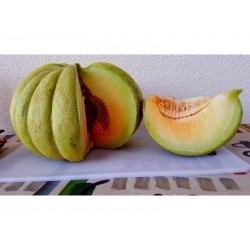Menu
-
MenuGeri
- Home
-
Kategoriler
-
-
Kategoriler
-
Sebze tohumları
-
Ülkelere Göre Çeşitler
- Ermenistan'dan çeşitler
- BH'den Çeşitler
- Hırvatistan'dan Çeşitler
- Fransa'dan Çeşitler
- Almanya'dan Çeşitler
- Yunanistan'dan Çeşitler
- Macaristan Çeşitleri
- Hindistan'dan Çeşitler
- İtalya'dan çeşitleri
- Japonya'dan Çeşitler
- Kuzey Makedonya çeşitleri
- Peru Çeşitleri
- Rusya'dan Çeşitler
- Sırbistan'dan Çeşitler
- Slovenya'dan Çeşitler
- İspanya Çeşitleri
- Tayland çeşitleri
- Türkiye'den Çeşitler
- ABD'den Çeşitler
- Domates tohumları
- Mısır tohumları
- Kabak ailesi
- Fasulye ailesi
- Salatalık tohumları
- Dolma biber tohumları
- Havuç ailesi
- Soğan ailesi
- Marul tohumları
- Patates ailesi
- Lahana ailesi
- Turp tohumları
- Pancar ailesi
- Karpuz tohumları
- Kavun tohumları
- Karnabahar tohumları
- Ayçiçeği ailesi
-
Ülkelere Göre Çeşitler
- Meyve tohumları
- Acı biber tohumları
- Tıbbi bitki tohumları
- Tırmanma bitki tohumları
- Ağaçlar - Çalı tohumları
- Palmiye tohumları
- Süs bitkileri tohumları
- Tütün tohumları
-
Sebze tohumları
-
-
-
-
- YENİ ÜRÜNLER
- Hesap oluştur
- Teslimat - Ödeme
- FAQ
Last Product Reviews
Out of the two seeds, one germinated and the other one was dead and floatin...
By
 Riikka H on 07/03/2024
Riikka H on 07/03/2024
Verified Purchase
36 adet ürün var.
Sıralama ölçütü:
Toplam 36 üründen 16-30 arası gösteriliyor

Türkiye'den Çeşit
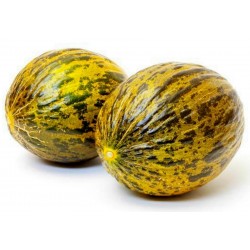
Dalaman Turkey Melon Fresh...
Fiyat
€2,15
(SKU: V 157)
Seeds Gallery EU,
5/
5
<h2><strong>Dalaman Melon Fresh Seeds</strong></h2><h2><span style="color:#ff0000;"><strong>Price for Package of 10, 20, 50 seeds.</strong></span></h2><p>Mid-early standard melon variety from Turkey is suitable for all areas. 4-6 kg in weight. Slightly grooved thick skin is very dark green spotted on yellowish green color. Flesh is juicy, tasty and white in color. Suitable for transportation. Potential yield is 2-3 ton/ da under suitable conditions. Suitable for all soil conditions, fresh consumption and export.</p>
V 157 (10 S)


Türkiye'den Çeşit
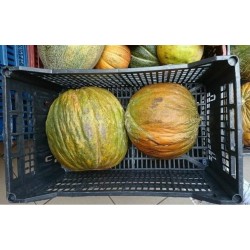
Casaba Turkish melon seeds
Fiyat
€1,95
(SKU: V 214)
Seeds Gallery EU,
5/
5
<h2><strong>Casaba Turkish melon seeds</strong></h2>
<h2><span style="color:#ff0000;"><strong>Price for Package of 10 seeds.</strong></span></h2>
<p>The Casaba melon is unique in its appearance, thus once identified it is easily recognized. It has an ovoid to round shape that comes to a point at its stem end. When ripe its skin will be a golden yellow with hints of green throughout. Its thick rind has irregular, shallow furrows running from end to end. The creamy pale green to white flesh is mild and sweet in flavor with nuances of Asian pear. Unlike other muskmelon varieties its aroma is very subtle and its skin is void of the typical netting.</p>
<p><strong>Seasons/Availability</strong></p>
<p>Casaba melons are available summer through the early winter.</p>
<p><strong>Current Facts</strong></p>
<p>Botanically known as Cucumis melo var inodoras and a member of the Cucurbitaceae family, the Casaba melon is a unique variety of muskmelon. They belong to the winter melon group, which also includes honeydew melons. The winter melon classification is attributed to their growing season, their hardiness and long shelf-life. Casaba melons are a parent melon along with a cantaloupe variety to the Crenshaw melon.</p>
<p><strong>Applications</strong></p>
<p>Casaba melons are best utilized in fresh preparations. Its flavor will work well in both sweet and savory salads. Pureed it can be added to cold soups, smoothies, sorbets, sauces and cocktails. The Casaba melon pairs well with curry, cucumber, chilies, lime, red onion, mint, basil, coconut milk, ricotta, mozzarella and cottage cheese. An excellent keeper once ripe uncut Casaba melon will keep at room temperature for up to two weeks. Refrigerate cut up melon in a covered container up to three days.</p>
<p><strong>Geography/History</strong></p>
<p>The Casaba melon was introduced to the United States in the late nineteenth century when it was imported from Kasaba, Turkey. Unlike several melon varieties, the Casaba does not "slip" from the vine at maturity. The fruits are harvested by cutting the stem when the melons are reasonably mature and then held in storage until the blossom end becomes soft. </p>
V 214 (10 S)

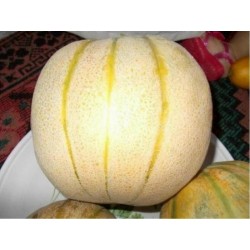
TALIBI Persian Melon Fresh...
Fiyat
€1,95
(SKU: V 171)
Seeds Gallery EU,
5/
5
<h2><strong>TALIBI Persian Melon Fresh Seeds</strong></h2>
<h2><span style="color: #ff0000;"><strong>Price for Package of 5 seeds.</strong></span></h2>
<p>Origin: Turkey. Rind: Round, netted with green sutures. Flesh: Orange. A large 'typical' rockmelon. </p>
<p>One of the most delicious melon you'll ever taste. You can expect success from these carefully selected Melon seeds. These vigorous, strong absolute winners have been chosen to meet your highest expectations.</p>
<p><strong>Fruit weight 2,5 - 4 kg</strong></p>
<script src="//cdn.public.n1ed.com/G3OMDFLT/widgets.js"></script>
V 171 (5 S)


Amerika Birleşik Devletleri'nden çeşitli

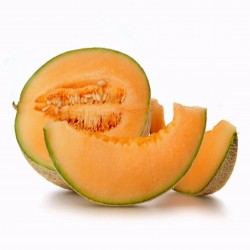
Hales Best Jumbo Melon Seeds
Fiyat
€2,15
(SKU: V 216 D)
Seeds Gallery EU,
5/
5
<h2><strong>Hales Best Jumbo Cantaloupe Melon Seeds</strong></h2>
<h2><span style="color:#ff0000;"><strong>Price for Package of 10 seeds.</strong></span></h2>
<p>HEIRLOOM. This muskmelon became widely popular because it combined excellent flavor with earliness. Hales Best Jumbo was developed by a Japanese market gardener in California around 1920. It became widely popular because it combined excellent flavor with earliness. It's a beautiful oval melon with deep green skin and golden netting. he fruit weighs 2 – 2,5 kg, the flesh is an appealing salmon color, aromatic and sweet.</p>
V 216 D (10 S)


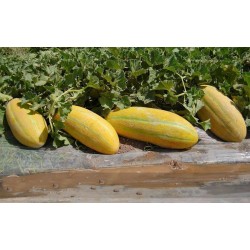
Melon MESHEDI Fresh Seeds
Fiyat
€2,50
(SKU: P 249)
Seeds Gallery EU,
5/
5
<h2><strong><em><span style="text-decoration:underline;">Persian Melon MESHEDI Fresh Seeds</span></em></strong></h2>
<h3><span style="color:#ff0000;"><strong>Price for Package of 5 seeds.</strong></span></h3>
<p>large green MUSKMELON with a delicate netting on the rind and a rich salmon-colored flesh. Persian melons weigh around 5 pounds (larger than a CANTALOUPE) and have a delicious, sweet flavor. They're available from July through October, with a peak in the late summer. Choose Persian melons that are heavy for their size; the rind should be pale green with a delicate netting. Avoid melons with soft spots. Store unripe Persian melons at room temperature, ripe melons in the refrigerator for up to 5 days. Just before serving, cut melon in half and remove the seeds.</p>
<p> </p>
P 249


Japonya'dan çeşitli
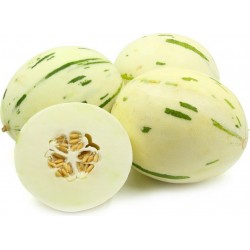
SNOW LEOPARD Melon Seeds -...
Fiyat
€1,75
(SKU: V 165)
Seeds Gallery EU,
5/
5
<meta http-equiv="Content-Type" content="text/html; charset=UTF-8" />
<div id="idTab1" class="rte">
<h2><strong>SNOW LEOPARD Melon Seeds - VERY RARE</strong></h2>
<h2><span style="color: #ff0000;"><strong>Price for Package of 5 or 10 seeds.</strong></span></h2>
<p>Snow Leopard melon, very rare, exotic, sweet, delicious, beautiful, unique ...</p>
<p><strong>OTHER NAMES: IVORY GAYA MELON, SILVER STAR (SEREBRYANAYA ZVEZDA)...</strong></p>
<p><span>The Ivory Gaya melon has a unique variegated exterior, as the name suggests the base color of the skin is an ivory cream covered in small lime green speckles and streaks. A petite melon the Ivory Gaya has an oblong shape. Ivory Gaya melons have a thin outer rind, that when cut reveals a creamy white inner flesh. Toward the center of the melon the flesh is soft and juicy, the flesh closer to the skin of the Ivory Gaya melon will have a crisper texture. The Ivory Gaya offers a sweet flavor, with nuances of pear and honey. When ripe its blossom end will have a slight give and when at room temperature will offer a sweet and rich melon aroma. </span></p>
<p><strong>Seasons/Availability</strong></p>
<p><span>Ivory Gaya melons are available in the late spring and early summer months. </span></p>
<p><strong>Current Facts</strong></p>
<span>A member of the Cucurbitaceae or Cucurbit family the Ivory Gaya melon is of the muskmelon species and botanically known as Cucumis melo inodorus ‘Ivory Gaya’. Also known as the Snow Leopard melon the Ivory Gaya is often referred to as an "ice box" variety melon as a result of its petite size that easily fits in a crisper drawer. This honeydew cultivator is a specialty melon and sought after for its unique exterior coloring and sweet melon flavor. </span><br />
<p><strong>Applications</strong></p>
<span>Like many honeydew cultivator melons the Ivory Gaya has an exceptionally sweet flavored flesh that is ideal for fresh eating. Its petite size makes it perfect as a personal melon which can be halved and eaten as is for one. Pureed it can be used as a base for cold soups or sauces. Cubed it can be added to both fruit and green salads or used on fruit kebabs. Companion flavors include salty Italian meats such as salami and prosciutto, parmesan cheese, feta, balsamic vinegar, berries, grapes, tomato, olives and lime juice. Keep at room temperature until ripe. Uncut melons can be kept in the refrigerator for up to five days. Once sliced melon will keep best wrapped in plastic in the refrigerator and when used within three days. </span><br />
<p>Geography/History</p>
<span>The Ivory Gaya melon is native to Japan. In addition to Japan, today it can be found growing in China, Mexico, South America and in North America, specifically in southern California. A vining type the Ivory Gaya melon thrives in warm sunny conditions. Sill a rather unique variety melon in California the Ivory Gaya can be found at select Asian markets, farmers markets and specialty grocers. </span><br />
<div>
<div id="restaurantSlide"></div>
</div>
<p>Melons: <em>Cucumis melo</em><br />Watermelons: <em>Citrullus lanatus</em><br /><br />The sweet succulence of summer-ripe melons is irresistibly tempting, but the health benefits of these luscious fruits shouldn't be overlooked. Look to red-fleshed melons to fortify the heart and urinary tract. Yellow and orange flesh types provide support to the immune system, heart and vision. Green-fleshed varieties promote strong bones and teeth as well as vision health. We've selected varieties that are successful in both southern and northern gardens.<br /><br /><strong>CULTURE:</strong> All types of melons can be direct sown in warmer regions, but will yield a much better crop if started indoors about 3 weeks prior to your last frost. We recommend planting in raised beds covered with green, silver, or black plastic mulch. This method produces better yields.</p>
<p><br /><strong>FOR TRANSPLANTS:</strong></p>
<p>Fill 3-4 inch, individual pots with sterile seedling mix. Plant 2-3 seeds per pot. Thin the pots to the best single plant after the seedlings are well established. Grow the seedlings under dry, warm conditions until they develop at least 1 true leaf. Transfer to cold frame if you have one. Fertilize seedlings with a fertilizer such as 2-1-1 Earth Juice Grow (ZFE245). Transplant into the garden just before the plants become root bound and when the soil temperature is at least 60°F. Space transplants 3-4 feet apart in rows 5-6 feet apart. Apply 1/2 cup of our complete fertilizer dug in well around each plant.</p>
<p><br /><strong>TO DIRECT SOW:</strong></p>
<p>Soil temperature must be above 70°F for decent germination. Like most vine crops, melon and watermelon seeds require even moisture levels to prevent rotting. The soil should be moist to the touch. Space and fertilize as you would transplants. Watermelon seeds are less tolerant of cool conditions than cantaloupe. They are best adapted to the warmer, longer season areas of the US. In more difficult climates, the use of plastic mulch is highly recommended. Plastic mulches increase the soil temperature and air temperature close to the plants during the day, and using a floating row cover like Reemay or Gro-Therm can also increase your success. Monitor the temperature under the row covers on hot days especially early in the season.</p>
<p><br /><strong>DISEASES:</strong></p>
<p>Select disease-resistant melon varieties, as bacterial wilt and powdery mildew are common problems. Watermelons are subject to several wilts, and fungal and viral diseases. Most can be controlled with good soil management, proper rotation, garden sanitation, and by not using overhead watering methods.</p>
<p><br /><strong>INSECTS/PESTS:</strong></p>
<p>Control insects, especially cucumber beetles, with Pyrethrin or a floating row cover.</p>
<p><br /><strong>HARVEST:</strong></p>
<p>Cantaloupe will easily slip from the vine when ripe. With other melons, check the leaf where the fruit is attached to the vine. The fruit is mature when this leaf begins to yellow. Watermelons are ready for harvest when the tendril closest to the fruit is dry and brown or when the bottom side of the fruit is yellow. Melons and watermelons will not ripen off the vine. Pick in the cool of the day and chill quickly. Store melons at 35°F and 95% relative humidity. Store watermelons at 45°F and 85% relative humidity.</p>
<p><br /><strong>SEED SPECS:</strong></p>
<p>Minimum germination standard: 80%. Usual seed life: 3 years. Days to maturity: from date of transplanting. Add 10-15 days if direct seeding.</p>
</div>
V 165 (5 S)

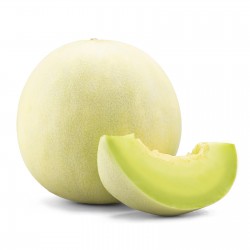
Honeydew Kavun tohumları
Fiyat
€1,95
(SKU: V 142)
Seeds Gallery EU,
5/
5
<h2><strong>Honeydew Kavun tohumları</strong></h2>
<h2><span style="color: #ff0000;"><strong>20 tohum paketi için fiyat.</strong></span></h2>
<p>Hafifçe oval yapıda yaklaşık 20 cm uzunluğundadır. Erken dönemlerde kabuk yüzeyi üzerinde yumuşak tüyler bulunur. Kabuk rengi başlangıçta yeşilimsi beyaz renkte iken daha sonra kremsi sarı renktedir. Meyve eti kalın, açık yeşil renkte olup sulu ve tatlı bir çeşittir.</p>
V 142 (20 S)

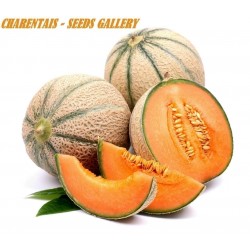
Charentais Melon Seed
Fiyat
€2,50
(SKU: V 85)
Seeds Gallery EU,
5/
5
<meta http-equiv="Content-Type" content="text/html; charset=UTF-8" />
<div id="idTab1" class="rte">
<h2><strong>Charentais Melon Seed</strong></h2>
<h2><span style="color: #ff0000;"><strong>Price for Package of 20 seeds.</strong></span></h2>
<div>Among many delicious melons that are too fragile to ship, the French cantaloupes are at the top of our list. Perfectly sized for a half-melon serving, the French Charentais types have thick, firm, orange flesh and a small seed cavity. When ripe, their smooth, blue-green skin turns yellow, and the melons slip easily from their stems. If those signs of readiness are not enough, just the aroma of a ripe Charentais in the patch is a dead giveaway. The flavor is perfumed and tropically exotic, too — distinct from the more typical netted-skinned varieties.</div>
<div><em><strong>Cucumis melo</strong></em></div>
<div><span style="color: #008000;"><strong>Planting Tips:</strong></span></div>
<div><span style="color: #008000;">Can be direct sown in warmer climates after soil temperatures reach 70, plant 3-4 seeds 1/2” deep in hills 3-4’ apart on rows 5-6’ apart. Once established, thin to two strongest plants. For cooler climates we prefer to start in pots in the greenhouse and transplant later when night time temperatures stay above 55 degrees. Start seedlings 3 weeks before last frost. Once seedlings are 4” tall and soil temperatures are 70, plant in rich loose soil.</span></div>
<div><span style="color: #008000;">Keep well watered until fruits are tennis ball sized and then water only if absolutely needed. (We know organic farmers that never water them and grow amazinging melons, but a great deal depends on your soil.)</span></div>
<div><span style="color: #008000;">Remember, you must have a healthy population of pollinators like bees to get a good fruit set.</span></div>
<div><span style="color: #008000;"><strong>Seeding Rate:</strong></span></div>
<div><span style="color: #008000;">4,500 plants/acre, aproximately 1/4-1/3 lb.</span></div>
</div>
V 85 (20 S)


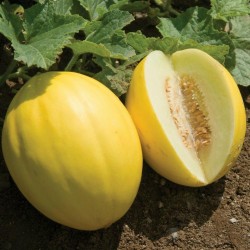
Canary Yellow Melon Seeds
Fiyat
€1,95
(SKU: V 84)
Seeds Gallery EU,
5/
5
<h2><strong>Canary Yellow Melon Seeds</strong></h2>
<h2><span style="color: #ff0000;"><strong>Price for a Package of 20 seeds.</strong></span></h2>
<div>
<div>The Canary melon (C. melo (Indorus group)) or winter melon is a large, bright-yellow melon with a pale green to white inner flesh. This melon has a distinctively sweet flavor that is slightly tangier than a honeydew melon. The flesh looks like that of a pear but is softer and tastes a little like a cantaloupe. When ripe, the rind has a slightly waxy feel. The name comes from its bright yellow color, which resembles that of the canary. This melon is often marketed as the Juan Canary melon or "variety melons" and can be found in various sizes and shapes. This melon is common in parts of Asia, e.g., Japan and South Korea.</div>
<div>The outer skin of the canary melon is softer than that of cantaloupe or honeydew, and preparation of the melon for consumption is best administered with a knife. The elasticity of the skin resists blunt trauma induced from chopping, punching or hammering.</div>
<div>They are best stored at 15°C.</div>
</div>
<div>Melons are a refreshing and delicious addition to your garden. With so many sizes, shapes, and tastes, there is a type of melon that just about everyone loves. Some well-known melon varieties include muskmelon, watermelon, honeydew, and cantaloupe.</div>
<div> </div>
<div><strong>Planting, Growing, and Harvesting:</strong></div>
<div>Plant melons in soil with plenty of calcium to help prevent blossom-end rot from occurring. Melons do best in warm soil with plenty of nutrients. You can direct-sow the seeds in rows, or by planting them in hills with a few seeds in each to improve drainage and soil warmth. Be sure melons get a steady water supply. When planting, keep in mind that melon vines with take up a good amount of space in the garden, with some kinds stretching up to 10 or 20 feet. You can grow some melons vertically if you prefer, using a strong, large trellis.</div>
<div> </div>
<div>Harvest melons by cutting them from the vine once they are ripe. There are some ways to help you figure out if melons are ripe and ready to pick. In general, look for a dull thumping noise when you tap on the melon, a sweet fragrance when smelling the rind, softening, and changes in color.</div>
<div> </div>
<div><strong>Recipes/How to Use:</strong></div>
<div>Melons are wonderful all by themselves. You can also add them to fruit salads, desserts, or blend them into drinks.</div>
<div> </div>
<div><strong>Refreshing Melon Smoothie</strong></div>
<div>1/2 cup yogurt</div>
<div>6 ounces melon (such as cantaloupe or honeydew), cut into cubes</div>
<div>1/2 banana</div>
<div>3-4 strawberries</div>
<div>1/2 cup juice of your choice (such as orange or apple juice)</div>
<p>Add ingredients to a blender and blend completely. For a thicker smoothie, use frozen, cut-up fruit.</p>
<div> </div>
<table border="1" cellspacing="0" cellpadding="0">
<tbody>
<tr>
<td colspan="2" valign="top" width="100%">
<p><span style="color: #008000;"><strong>Sowing Instructions</strong></span></p>
</td>
</tr>
<tr>
<td valign="top" nowrap="nowrap">
<p><span style="color: #008000;"><strong>Propagation:</strong></span></p>
</td>
<td valign="top">
<p><span style="color: #008000;">Seeds</span></p>
</td>
</tr>
<tr>
<td valign="top" nowrap="nowrap">
<p><span style="color: #008000;"><strong>Pretreat:</strong></span></p>
</td>
<td valign="top">
<p><span style="color: #008000;">0</span></p>
</td>
</tr>
<tr>
<td valign="top" nowrap="nowrap">
<p><span style="color: #008000;"><strong>Stratification:</strong></span></p>
</td>
<td valign="top">
<p><span style="color: #008000;">0</span></p>
</td>
</tr>
<tr>
<td valign="top" nowrap="nowrap">
<p><span style="color: #008000;"><strong>Sowing Time:</strong></span></p>
</td>
<td valign="top">
<p><span style="color: #008000;">all year round</span></p>
</td>
</tr>
<tr>
<td valign="top" nowrap="nowrap">
<p><span style="color: #008000;"><strong>Sowing Depth:</strong></span></p>
</td>
<td valign="top">
<p><span style="color: #008000;">0,5-1 cm</span></p>
</td>
</tr>
<tr>
<td valign="top" nowrap="nowrap">
<p><span style="color: #008000;"><strong>Sowing Mix:</strong></span></p>
</td>
<td valign="top">
<p><span style="color: #008000;">Coir or sowing mix + sand or perlite</span></p>
</td>
</tr>
<tr>
<td valign="top" nowrap="nowrap">
<p><span style="color: #008000;"><strong>Germination temperature:</strong></span></p>
</td>
<td valign="top">
<p><span style="color: #008000;">20 ° C</span></p>
</td>
</tr>
<tr>
<td valign="top" nowrap="nowrap">
<p><span style="color: #008000;"><strong>Location:</strong></span></p>
</td>
<td valign="top">
<p><span style="color: #008000;">bright + keep constantly moist not wet</span></p>
</td>
</tr>
<tr>
<td valign="top" nowrap="nowrap">
<p><span style="color: #008000;"><strong>Germination Time:</strong></span></p>
</td>
<td valign="top">
<p><span style="color: #008000;">1-6 weeks</span></p>
</td>
</tr>
<tr>
<td valign="top" nowrap="nowrap">
<p><span style="color: #008000;"><strong>Watering:</strong></span></p>
</td>
<td valign="top">
<p><span style="color: #008000;">Water regularly during the growing season</span></p>
</td>
</tr>
<tr>
<td valign="top" nowrap="nowrap">
<p><span style="color: #008000;"><strong> </strong></span></p>
</td>
<td valign="top">
<p><br /><span style="color: #008000;"><em>Copyright © 2012 Seeds Gallery - Saatgut Galerie - Galerija semena. </em><em>All Rights Reserved.</em></span></p>
</td>
</tr>
</tbody>
</table>
V 84 (20 S)

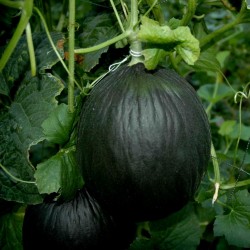
Black Melon Seeds
Fiyat
€2,45
(SKU: V 47)
Seeds Gallery EU,
5/
5
<h2><strong>Black Melon Seeds</strong></h2>
<h2><span style="color:#ff0000;"><strong>Price is for pack of 10 seeds.</strong></span></h2>
<p>The fruit has good size (2 - 3 kg.). The flesh is light green, and is very sweet and tastes a little bit like the taste of pineapple. Due to black color, it's very good for the region where is not much sun and where the beautiful sunny days are rare because as we all know black attracts the sun's rays more than any other color, so that the melons ripen in record time and a lot less than all other varieties </p>
<p><a href="http://www.youtube.com/watch?v=Hje7-Pl9ryQ&feature=youtu.be" target="_blank" style="background-color:#ffffff;" rel="noreferrer noopener"><strong>http://www.youtube.com/watch?v=Hje7-Pl9ryQ&feature=youtu.be</strong></a></p>
V 47 (10 S)

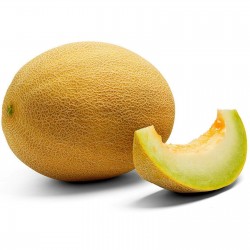
Ananas kavun tohumu
Fiyat
€1,85
(SKU: V 174)
Seeds Gallery EU,
5/
5
<h2><strong>Ananas kavun tohumu</strong></h2>
<h2><span style="color: #ff0000;" class=""><strong>30 (1g) tohum paketi için fiyat.</strong></span></h2>
<p>Geleneksel ananas kavun tohumu. Sulu mu sulu, tatlı mı tatlı bir kavun. 1800 yılından bu yana yüzyılı geçkin bir süredir üretilmeye devam etmektedir. Muskmelon varyetesi olup, bırakın mutfağa getirip kestikten sonra kokmasını dikili olduğu bahçeyi bile tatlı kokusu ile dolduran, iç meyve kısmı beyaz bir kavundur.</p>
<p>Satışta olan tohumlar işlenmemiş, ilaçsız, geleneksel tohumlardır. Yetiştirdiğiniz meyvesinden tohum alabilirsiniz. Meyveden aldığınız tohumları oda sıcaklığında, nem, rutubet, ışık almayan serince bir çekmece içinde saklayınız.</p>
<p><strong>Nasıl çimlendirilir ?</strong></p>
<p>Kavun ekildiği yerde büyüyen ve köklerinin oynatılmasından hoşlanmayan bir bitki olduğu için, evde başlatmanız önerilmez. Bunun yerine doğrudan don tehlikesi geçtikten sonra büyüyeceği yere dikin.</p>
<p>7-10 günde 24/27 derece ısıda çimlenen tohumları, toprağın yaklaşık 2.5 cm derinine ekin. Ekim toprağını önceden çapalamanız ve organik gübreyle zenginleştirmeniz çabuk ve sağlıklı büyümesini sağlar. Kavun filiz döneminde çok sulanırsa filiz çürür. Dikkatli ve yeterli sulayıp, aşırı sulamadan kaçının.</p>
<p>İç mekanda başlatacaksanız: Son donlar geçmeden 2-3 hafta önce çimlendirmeniz doğru olacaktır. Erken çimlendirmede bitki hızla büyüyecek toprağa alınmadan önce kapalı mekânda bakımı zorlaşacaktır.</p>
<p>Sağlıklı yetiştiricilik için püf noktalarını da dikkate alarak ekim yapınız. Ekim öncesi ılık içme suyunda 1-2 saat tohumları bekletiniz. Tohumları beklerken, ekim yapacağınız saksının içine kese kâğıdından ya da gazete kâğıdından, bitki filizlendikten sonra saksıdan alırken köklerinin dağılmasını engelleyecek bir düzenek yapın. Saksıdan filizi bu şekilde, kökler zarar görmeden toprağa aldığınızda, gazete birkaç hafta içinde toprakta eriyecek, kökler sağlıklı gelişecektir. Tohumu bu şekilde hazırladığınız saksılara doldurulan nemli çimlendirme torfuna yaklaşık 2.5 cm derinliğe ekip, sulayın.</p>
<p>Çimlenme 7-10 günde 24-27 °C yüksek sıcaklıkta gerçekleşir. Filizlenen bitki; dış mekâna son don tehlikesi geçtikten sonra yukarıda bahsedilen usulle dikkatlice alınmalı, gerekirse toprağın ısınması beklenmelidir. Ekim toprağı tohum ekildiği gün yani bitki toprağa alınmadan önce havalandırılmalı, organik gübreyle beslenmelidir. Bitki toprağa alınana kadar dinlenen toprakta daha hızlı ve sağlıklı gelişir.</p>
<p><strong>Bakımı ve diğer bilgiler</strong></p>
<p>Bitkiler 10-15 cm boya ulaştıklarında ilk çapa yapılır ve bitkilerin boğazları doldurulur. Yabancı ot durumuna göre bitki toprak yüzeyini örtene kadar çapa yapılır. Sulamada dikkatli olunmalıdır. Fazla su iriliği sağlasa da tat ve aromayı bozmaktadır. Hasat döneminde sulama yapılmaz. Yavaş yarayışlı Kompost hayvan gübresi, peletli gübreler ve organik gübrelerle desteklenen toprakta yetişen kavun bol hasat verir.</p>
<p><strong>Ne zaman hasat edilir?</strong></p>
<p>Tam olum evresindeki kavunlar, karpuzun aksine ağırlaşır. Meyve saplarının ve gövde üzerinde bulunan kulakçıklar kurur, meyve sapı tamamen kurur, meyvenin çiçek burnu hafifçe yumuşar, dip kısmı kendine has koku verir, irilik ve şekil olarak çeşit özelliğini gösterir durumlar hasat olgunluğuna işaret eder.</p>
<p><strong>Nerede yetiştirilir ?</strong></p>
<p>Küçük bahçe ve tarla üretimine uygun. Geleneksel tarım teknikleri ile yetiştiriciliğe uygun.</p>
<p><strong>Diğer</strong></p>
<p>Bu ürün geleneksel tür olduğundan tohumu alınarak nesli devam ettirilebilir. Alınan tohumdan her yıl aynı kalitede bitki yetiştirebilirsiniz. Çiçek başı geçtikten sonra oluşan tohum keselerinden aldığınız tohumları oda sıcaklığında, nem, rutubet, ışık almayan serince bir çekmece içinde saklayınız.</p><script src="//cdn.public.n1ed.com/G3OMDFLT/widgets.js"></script>
V 174 (30 S)


Ermenistan'dan Çeşit
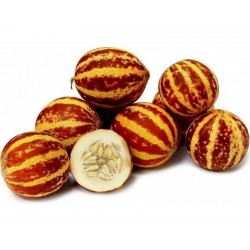
Tigger Kavun Tohumları
Fiyat
€4,95
(SKU: V 46)
Seeds Gallery EU,
5/
5
<meta http-equiv="Content-Type" content="text/html; charset=UTF-8" />
<h2><strong>Tigger Kavun Tohumları</strong></h2>
<h2><span style="color: #ff0000;"><strong>5 tohum paketi için fiyat.</strong></span></h2>
<p>Güçlü ve yoğun bir egzotik tat ve koku ile karakterizedir ve aynı zamanda çok dekoratiftir. Küçük boyutlu meyveler 150-450 gr ağırlığındadır. Tigger kavun bitkileri asma başına yirmi kavun verebilir. Yetiştirdiğimiz en muhteşem görünümlü kavun.</p>
<p>Tigger kavunun yumuşak kabuğu, dikey pas turuncu ve sarı renklere sahiptir. Kavunun kremsi, kirli beyaz eti sulu ve tatlıdır ve Asya armudu ve kavun ile karşılaştırılan bir tada sahiptir. Çoğu misk kavunu türü gibi, oldukça aromatik bir koku sunar ve olgunluğun zirvesindeyken içinde bulundukları tüm odayı parlattığı bilinmektedir. Tigger kavunları, yaklaşık olarak bir softball büyüklüğünde büyüyecek ve tamamen olgunlaştıklarında mütevazı bir pound ağırlığında olacaktır.</p>
<p>Tigger kavunu ilk olarak Dicle Nehri yakınında eski batı Ermenistan'da keşfedildi. Çoğu kavun çeşidi gibi, ılıman ve Akdeniz bölgelerinde yazın ılıktan sıcağa büyüyen günlerini tercih eder. Tırmanan asmalar üzerinde büyüyen Tigger kavunun küçük boyutu, onu nispeten küçük alanlarda yetiştirilmesine izin veren kafes için ideal hale getirir.</p>
V 46 (5 S)

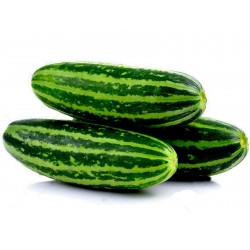
Sweet Thai Musk Melon Seeds
Fiyat
€1,95
(SKU: V 37)
Seeds Gallery EU,
5/
5
<h2><strong>Sweet Thai Musk Melon Seeds</strong></h2>
<h2><span style="color:#ff0000;"><strong>Price for Package of 10 seeds.</strong></span></h2>
<p>This Thai melon (Tang Thai) is very popular in Thailand, has an oval shape with yellow skin, 2-3 kgs in weight. The fruit is delicious and has an excellent smell. The young fruit is used canned or pickled, while mature fruit has a delicious smell, and it is used for making refreshing desserts.<br />Good resistant to deceases and easy to grow. <br />Maturity is in 70-80 days after sowing.</p>
V 37 (10 S)


Japonya'dan çeşitli

Yubari King Kavun Tohumları
Fiyat
€4,95
(SKU: V 2)
Seeds Gallery EU,
5/
5
<meta http-equiv="Content-Type" content="text/html; charset=UTF-8" />
<h2><strong>Yubari King Kavun Tohumları Dünyanın en pahalı meyvesi</strong></h2>
<h2><span style="color: #ff0000;"><strong>Paket Fiyatı 5, 10, 50 tohum.</strong></span></h2>
<p>TOKYO Japonya'da müzayedede olan oldukça tatlı bir kavun rekoru 12.000 dolar getirerek ülkedeki şimdiye kadar satılan en pahalı kavunlardan biri haline geldi.</p>
<p>In a society where melons are a luxury item commonly given as gifts the jaw-dropping auction last month shocked everyone! At that auction, a pair of "Yubari" cantaloupe melons sold for a record $23,500. Wikipedia Yubari</p>
<p>A pair of cantaloupes from the bankrupt city of Yubari, Hokkaido, fetched a whopping 2 million yen at the first auction of the season at the Sapporo central wholesale market, the Japan Agricultural Cooperative's Yubari unit said. The price paid by Marui Imai Inc., a Sapporo-based department store, for the upmarket produce surpassed the previous record of 800,000 yen for two cantaloupes, JA Yubari said. "Perhaps the city's designation as a financially rehabilitating entity ironically helped generate an advertising effect," said a spokesperson for the former coal town, which went bankrupt last year. "This will encourage the city a lot."</p>
<p>The two melons were put on display at Marui Imai's flagship outlet priced at 1 million yen apiece. Yoshikazu Hoshino, 59, a purchasing officer at the department store, said the cantaloupes were more for publicity than profit. "We were bullish in the bidding because we're celebrating our 135th anniversary this year. We wanted as many customers as possible to see them," he said. One of the million-yen fruits has already been sold, the store said. Other shoppers were stunned by the price.</p>
<p>"It's not a price I can afford," said Ryoko Hino, a 79-year-old shopper.</p>
<p>So the Yubari King costs generally from 100 to 1000 € / piece.</p>
<p>How to Cultivate Yubari King Melon</p>
<p>Side Selection</p>
<p>Try to plant in a location that enjoys full sun and remember to water often. Keep in mind when planting that Yubari King is thought of as hardy, so this plant will survive close to or on freezing temperatures.</p>
<p>Soil</p>
<p>The soil the melons are grown in is volcanic ash. It's not what's in the volcanic soil, but how the soil behaves. It lets growers there easily control the temperature of the soil, and the ash lets water quickly drain through, allowing for the top to remain dry, which promotes the size of the melons. Yubari King needs a potting mix soil with a ph of 6.1 to 7.5 (weakly acidic soil to weakly alkaline soil). You just buy a bag of compost and add it to your soil to feed your plants. It is not only better for them, it is also cheaper.</p>
<p>Seeding:</p>
<p>Try to aim for a seed spacing of at least 1.89 feet (58.0 cm) and sow at a depth of around 0.5 inches (1.27 cm). Soil temperature should be kept higher than 21°C / 70°F to ensure good germination. By our calculations, you should look at sowing Yubari King about 14 days before your last frost date.</p>
<p>Ensure that temperatures are mild and all chance of frost has passed before planting out, as Yubari King is a hardy plant.</p>
<p>Planting</p>
<p>Melon is planted in February. The first ones are ready to harvest 105 days after planting. The growing season ends in early September. Cutaway any diseased or pest damaged leaves first. This will enable the plant to put all of its energy into making a great Melon instead of making more leaves. Melons are an annual, not a perennial. They can grow more than 1 harvest but the first is always the best but if you have an heirloom and need the extra seed then let more fruit set after your first harvest. DO NOT let fruit set until AFTER your first harvest so all of the plant's energy (sugars) go into the Melon(s) on the vine.</p>
<p>At long last, to see flowers appearing on the vines, which means melons are on their way! It seems like it takes forever but really it only has been a little over a month or so.</p>
<p>Watering and Fertilizer You have covered this in the past but things change when the melons start to grow. You should water them every other day if your soil is well-drained. Keep an eye on the top of the soil and water when the top is dry to a depth of about ½ inch. There should never be a fear of overwatering if your soil drains well and containers have holes for excess water to leave from. Remember, very dry soil sheds water like a Ducks back. It will take time for the water to soak into the soil and you will have a lot of run-offs until it rehydrates. Never water with cold water since it will shock the plant a little and may slow growth or development of fruit. You may need to water every other day with 1 gal of water for every 4 cubic feet of growing medium but you might decide that you want to waterless. Your local weather will also play a role.</p>
<p>If you started with a soil mix of compost, you should not need to fertilize your plants. You can do, however, like to add ½ tsp of Super Thrive to every 2 gallons of water. This will help them resist pests and develop much stronger. After the fruit gets to the size of a grapefruit You can use only water until harvest.</p>
<p>Pollinate</p>
<p>Melons will not appear out of anywhere. There needs to be a male and female flower for the Melon to form. The fruit will grow from the female flower. Male flowers are the first to appear on the plant. If you have other Melons growing in your yard then you might consider covering the Ichiba Kouji with a mosquito net to keep bees from pollinating your other melons, especially if they are an heirloom. When the female flowers appear, take a male flower and place it inside the female flower or use a small dust brush and swab the inside of the male flower and then swab the female flower to pollinate. You can also let bees do this for you if you wish. Only 2 Melons (at most) should be grown on the vine at a time. Each plant should yield 4 or more Melons if you let them but they will be smaller and lower quality. “I must sacrifice the others to make the best one possible.” - Japanese Melon Grower The Japanese master growers hand pollinate three flowers and let them get to about the size of a baseball, then select the best one and let only that one grow. The others can be chopped up and added to the compost pile.</p>
<p>When Melons burst!</p>
<p>The inside of the melon is growing so fast that the outside can’t keep up so a crack forms. At this point, the plant's sugars flow out to cover the crack and heal the melon. This is supposed to happen, in fact, if it doesn’t your doing something wrong. This is what forms the reticulation or netting. The finer the reticulation is, the juicier the inside is.</p>
<p>“If the reticulation is great, the inside is great too.” – Japanese Melon Judge</p>
<p>If you don’t make good netting, then you don’t make a good melon. This is where art makes an entrance. It is something that you’re going to have to experiment with to get the melon just the way you like them. If you just set it on the ground, then the melon will not form a perfect circle and the netting may be affected, not to mention bugs getting into them. If you put them on a trellis then the juices may not be evenly distributed or may become misshapen or even caught inside the trellis if you’re not careful. This is why you can use them to hang the melon so that it would not be disturbed.</p>
<p>Harvesting</p>
<p>After the cracking is over with and the melon is healed it is time for the next technique. Several times until you’re ready to harvest, you need to put on some cotton work gloves and rub firmly all around the melon. You should do this twice a week. For example Monday and Thursday. The reason for doing this is to make the Melon sweeter.</p>
<p>“This is called Tama Fuki. It stimulates the melon and adds sweetness.” – Japanese Melon Grower</p>
<p>Melons are hard to tell when they are ripe. They stay green and on the vine. So how do you know when they are ready? </p>
<p> 1. The stem is “green and strong” (dry)</p>
<p> 2. The bottom of the Melon is “flexible” (slightly soft)</p>
<p> 3. It should feel heavier than it looks.</p>
<p> 4. You should smell the Melon aroma when in close proximity.</p>
<p>Pest and Diseases:</p>
<p>Quality</p>
<p>To most Americans, your melon will taste just like a regular melon. A really good melon but unless they know what they have in their hands then they will most likely overlook the quality. Only when they bite into a regular store-bought melon will they realize what they once held. The quality of your melon can be seen without cutting it open. If you look at a store-bought melon, you will see that the “netting” or reticulation is very fine or small. A great melon will have more pronounced or thicker lines in the reticulation. This quality level depends mostly on the watering schedule that is set. Personally we found that watering every other day to work best in my area but that may change depending on your climate. Remember that melons come from a desert environment. We wish you luck in your melon growing adventures!</p>
V 2 (5 S)






